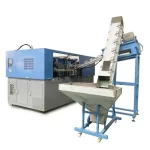Plastic hollow blow molding machines are widely used in various industries for manufacturing plastic containers, bottles, and other hollow products. However, like any other machinery, these machines require regular maintenance to ensure their optimal performance and longevity. In this article, we will discuss some essential maintenance methods for plastic hollow blow molding machines.
1. Cleaning and Lubricating
Proper cleaning and lubrication are crucial for the smooth operation of a plastic hollow blow molding machine. Regularly clean the machine using appropriate cleaning solutions to remove any accumulated dust, debris, or plastic residues. Pay special attention to the molds, as any dirt or residue on them can affect the quality of the final product. After cleaning, make sure to dry all the parts thoroughly to prevent the formation of rust or corrosion.
In addition to cleaning, lubrication is necessary to reduce friction and wear in the moving parts of the machine. Use high-quality lubricants recommended by the manufacturer and apply them to the designated points according to the machine’s manual. Proper lubrication not only ensures smooth functioning but also extends the lifespan of the machine.
2. Inspection and Maintenance of Components
Regular inspection and maintenance of the various components of a plastic hollow blow molding machine are vital to identify and address any potential issues promptly. Some key components that require attention include:
- Heating elements: Check the heating elements regularly to ensure they are functioning properly. Replace any faulty elements promptly to maintain consistent and efficient heating.
- Air compressor: Inspect the air compressor for any leaks, worn-out parts, or unusual noises. It is crucial to maintain proper air pressure for the machine to operate effectively.
- Hydraulic system: Monitor the hydraulic system for any leaks, damaged hoses, or low fluid levels. Regularly top up the hydraulic fluid and replace it as required.
- Molds and die heads: Examine the molds and die heads for any signs of damage, cracks, or wear. Replace worn-out parts to ensure the production of high-quality products.
Additionally, check all the electrical connections, sensors, and control panels for any loose connections or malfunctions. Electrical issues can disrupt the machine’s operation and lead to production delays.
3. Training and Operator Maintenance
The operators of plastic hollow blow molding machines play a significant role in their maintenance. It is essential to provide thorough training to the operators on how to operate, clean, and maintain the machine correctly. Proper operating techniques can minimize wear and tear, reduce the risk of accidents, and ensure the longevity of the machine.
Encourage the operators to perform routine maintenance tasks, such as cleaning, lubricating, and inspecting the machine, as part of their daily responsibilities. Implement a checklist system that outlines the maintenance tasks and their frequency. Regularly review the operators’ performance and provide feedback and guidance to maintain the highest standards of machine maintenance.
Regular maintenance is crucial for the optimal performance and durability of plastic hollow blow molding machines. By following proper cleaning procedures, lubricating the machine regularly, inspecting and maintaining the components, and providing adequate training to operators, you can ensure the smooth operation and prolonged lifespan of these machines. Remember, a well-maintained machine not only improves productivity but also reduces downtime and repair costs.
.webp)
